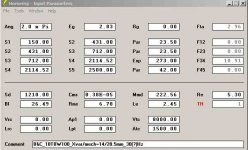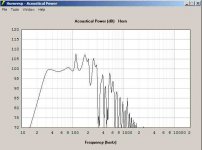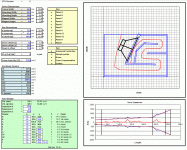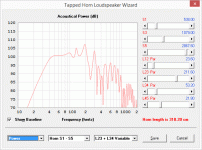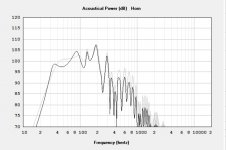I mentioned this before but no takers, I don't anyone ever built it, but I plan to someday: Crescendo's real six fold appears the best of low f3 and SPL. 98db 30hz 2.83v.
That said, I really like Brian's design and I hope he can get the low knee to 30hz!
Considering most of the popular designs are 5 years old, I figured someone would have gotten 100db @ 30hz 2.83v out of a single sheet by now... 😀
That said, I really like Brian's design and I hope he can get the low knee to 30hz!
Considering most of the popular designs are 5 years old, I figured someone would have gotten 100db @ 30hz 2.83v out of a single sheet by now... 😀
A few people built the 6fold design. If you read the flat to 30hz thread you would see most of them.
That said, I really like Brian's design and I hope he can get the low knee to 30hz!
I'm a fan of the SS15 fold (compared to some of the others I've seen), because the small baffle and panels near to the S1 area keep panel flex to the minimum where pressure is likely to be the highest. And part of the fold neatly reinforces the top panel as well, reducing panel flex there too. If I can get the split-panel thing to work, even better. "SS15-2" layout, anyone? 🙂
I doubt that it will get Fb down to below 30 Hz though. That requires adding an extra 100cm to the path length, and I don't think the split-panel approach is going to do that. BTW, I got one of the dimensions slightly wrong - was supposed to be 22.5", not 22". I modded the layout accordingly, and Fb comes up to around 38 Hz. Still 10 Hz higher than the Danley design. Face it - the man's a Folding Genius... 🙂
I'll be happy if I can get it down to 34 Hz or so. Still, that requires adding another 28cm to the path length. Splitting that first inner panel as previously indicated should get most of that. Of the remainder, hmm, perhaps truncating the sharp corner behind the first inner panel? Don't know how to sim the results in HornResp though - it would be a bit like adding a small chamber at S1 rather than in front or behind the driver, and HornResp can't sim that.
A few people built the 6fold design. If you read the flat to 30hz thread you would see most of them.
I am sick as a dog so I re-read... 😀 Thanks; not sure how I missed it. From what I can tell, 2 built it. Crescendo and another guy who was doing 4. I think Crescendo's build was OSB and the other dude never posted...
Mrgsr or whatever built one. He then built the TH18 and just didnt see why he would lug around the bugger box.(6 fold) Then he decided to do something smaller and made the Lab 12 TH12 sub that has the same type of BW as the TH18 but in 12 size.I am sick as a dog so I re-read... 😀 Thanks; not sure how I missed it. From what I can tell, 2 built it. Crescendo and another guy who was doing 4. I think Crescendo's build was OSB and the other dude never posted...
Attachments
Yeah, there's similar fold designs available, but have yet to see one like this except two single cabs laid out in dual stacks to mimic it.
GM
GM
Here is one by epa:
http://www.diyaudio.com/forums/subwoofers/231339-double-15-th-18-sound-15-nlw9401-4r.html
Regards,
http://www.diyaudio.com/forums/subwoofers/231339-double-15-th-18-sound-15-nlw9401-4r.html
Regards,
Brian, joking on the 30hz thing, but would love to see one emerge the SS folding pattern someday. I am anxious to learn more about cone volume correction. Wonder if there is a way to model something simple and build small scale to learn? I find it quite odd that it is commonly agreed around here and the web that path smoothing (unsure of the correct terminology) just reduces Fb but yet all Danley patents show substantial improvements in that regard.
I must be in minority but I do not think the 6 fold (36" deep) is all that much larger than the TH118 (24"). Now the LabSub is another matter... I mentioned this before but the bright minds in this thread, any chance something like 60X36X24 could hit 100db 30hz 1W or is this basically not possible? (30ft3 or 850liters) I am not there yet with HR but I would love to see if I could mod the SS fold into the above dimensions and see what it does... Maybe even try dual 15s? I can't help but wonder if that is the new "bar" especially with all the recent requests for monster dual 18" cabs...
I must be in minority but I do not think the 6 fold (36" deep) is all that much larger than the TH118 (24"). Now the LabSub is another matter... I mentioned this before but the bright minds in this thread, any chance something like 60X36X24 could hit 100db 30hz 1W or is this basically not possible? (30ft3 or 850liters) I am not there yet with HR but I would love to see if I could mod the SS fold into the above dimensions and see what it does... Maybe even try dual 15s? I can't help but wonder if that is the new "bar" especially with all the recent requests for monster dual 18" cabs...
I am anxious to learn more about cone volume correction. Wonder if there is a way to model something simple and build small scale to learn? I find it quite odd that it is commonly agreed around here and the web that path smoothing (unsure of the correct terminology) just reduces Fb but yet all Danley patents show substantial improvements in that regard.
Simulations show that "cone correction" does nothing. Changing the volume of the throat chamber makes very little difference (unless you make a massive change). Some of the more prolific members of this forum have said as much too.
Can you post a link to the Danley patent that covers cone correction? I've never heard of such a thing and I am interested.
JAG, this is where I would love to see some tests instead of relying on sims. It is pretty much agreed in the XOC1 TH118 thread that DSL cone correction is only thing keeping it from being identical to the real thing. If cone correction doesn't do anything, why would DSL do it? I tend to think it might help output but like I said, I am learning...
I should have started a new sentence. 😀 The patents I referred to were not relating to cone correction, but building up corners etc along path length and smoothing pathway. But, now I see they are both somewhat related.
I should have started a new sentence. 😀 The patents I referred to were not relating to cone correction, but building up corners etc along path length and smoothing pathway. But, now I see they are both somewhat related.
If this picture is accurate there's more differences than just the "cone correction".

Why would DSL do it? Why not, it's one way to lay this out, it adds path length without actually taking up space to form the path, the cone itself forms the path.
In the XOC1 TH18 thread there are a bunch of subjective impressions of "cone correction" but as far as I know no one has measured anything, no one has objectively compared a "cone corrected" version to one without, or compared either "cone corrected" or not to a DSL TH118. So I'll remain extremely skeptical that this does anything at all until proven otherwise. Sims don't lie. They sometimes don't tell the whole story but the wildly positive claims and attributes connected to this odd tweak are not backed up by the sims or by any objective measurement. This is par for the course in audio though, people have pretty wild imaginations and rarely do the work required to back up their subjective opinions.
(When I say "odd tweak" I'm talking about people filling up the horn path with scraps of wood, not the way DSL does it in the pic above, which is kind of smart as it adds path length without taking space from the cab volume. The way DSL does it here though, will lead to a highish compression ratio, which isn't necessarily a good thing.)

Why would DSL do it? Why not, it's one way to lay this out, it adds path length without actually taking up space to form the path, the cone itself forms the path.
In the XOC1 TH18 thread there are a bunch of subjective impressions of "cone correction" but as far as I know no one has measured anything, no one has objectively compared a "cone corrected" version to one without, or compared either "cone corrected" or not to a DSL TH118. So I'll remain extremely skeptical that this does anything at all until proven otherwise. Sims don't lie. They sometimes don't tell the whole story but the wildly positive claims and attributes connected to this odd tweak are not backed up by the sims or by any objective measurement. This is par for the course in audio though, people have pretty wild imaginations and rarely do the work required to back up their subjective opinions.
(When I say "odd tweak" I'm talking about people filling up the horn path with scraps of wood, not the way DSL does it in the pic above, which is kind of smart as it adds path length without taking space from the cab volume. The way DSL does it here though, will lead to a highish compression ratio, which isn't necessarily a good thing.)
Last edited:
Touche'. I think I see your point, at least that I think your making, is that the approach DIYers have with "cone correction" is that a simple addition (or band aid if you will) will offer a significant improvement, whereas your contention is only a uniquely designed fold which adds path length but no cab volume is the only true way to introduce significant improvement.
I still don't think it's going to add significant improvement no matter how it's done, it's just a clever way to get more path length without taking up any cab space the way DSL did it. But I don't think it has anything to do with improving anything. No more power handling, no reduced distortion, no more spl or whatever silly claims are being made about "cone correction". Cones are already correct, they don't need correcting. What we are really talking about is a throat chamber of a few liters and reducing that or not reducing it. It's really not going to make any significant difference at all.
Let's see measurements. I don't care even a little bit about subjective impressions and theories that have no base in theory.
Let's see measurements. I don't care even a little bit about subjective impressions and theories that have no base in theory.
Last edited:
JAG, I get it man. I want the data too; that's why I suggested a small scale experiment...
Oliver, that looks nice! What is that? Doesn't match any of the many models I have. 30hz is my cowbell, gotta have more!
Oliver, that looks nice! What is that? Doesn't match any of the many models I have. 30hz is my cowbell, gotta have more!
Brian, joking on the 30hz thing, but would love to see one emerge the SS folding pattern someday.
Here's a "modified SS15" fold, that uses the volume in front of the cone as part of the horn's path. I've still got to tweak the spreadsheet a bit, but it's usable at the moment. Thing is, given the TH118's given dimensions, Fb is still not reduced to anywhere near the published figure. I'd really love to know how Danley does it. This tweak of using the volume in front of the cone as part of the horn's path does extend the path length, but nowhere near the amount required to achieve a 28 Hz Fb.
Note, this is one of the designs I'm considering for construction for two B&C 18TBX100 drivers I have access to at the moment. I'll probably go for a simple OD constant-taper horn (i.e. a TL) instead. I'll lose 3dB of output in the passband, but that alignment will easily get down to 30 Hz in a slightly smaller volume, with a lot less funkiness happening between 100 Hz and 200 Hz too.
Attachments
Brian. if you check diaphragm displacement, you will see the excursion minima is indeed at 35hz (which would make this a 35hz tapped horn). the 18tbx100 does not have sufficient motor for it SD to extend low enough in a design of this nature.
The stronger the motor in a tapped horn design, the more severe the "peak" at Fb becomes, which props up the response down low (similar to the ported box situation)
Heres a pic of your tapped horn with the 4 ohm 18nlw9601 subbed in (response shown with 2v in vs 2.83v for the tbx 8 ohm). Notice that response is ugly (cause your compression ratio is much lower than this driver requires) BUT, look, response extends to 35hz.
The stronger the motor in a tapped horn design, the more severe the "peak" at Fb becomes, which props up the response down low (similar to the ported box situation)
Heres a pic of your tapped horn with the 4 ohm 18nlw9601 subbed in (response shown with 2v in vs 2.83v for the tbx 8 ohm). Notice that response is ugly (cause your compression ratio is much lower than this driver requires) BUT, look, response extends to 35hz.
Attachments
Hi Zwiller,
Post #37: "... What is that?...
The simulation in Post #36 is just a quick look at how large a TH would have to be to go to 30Hz (as shown in the simulation). I'll attach the respective sketch, it's a first stab at it, but got pretty close.
Regards,
Post #37: "... What is that?...
The simulation in Post #36 is just a quick look at how large a TH would have to be to go to 30Hz (as shown in the simulation). I'll attach the respective sketch, it's a first stab at it, but got pretty close.
Regards,
Attachments
- Status
- Not open for further replies.
- Home
- Loudspeakers
- Subwoofers
- Dual 18 Tapped Horn Design Concept

